ACC00724 - Financial Performance Evaluation of JB Hi-Fi
VerifiedAdded on 2021/12/29
|14
|1742
|20
AI Summary
Contribute Materials
Your contribution can guide someone’s learning journey. Share your
documents today.
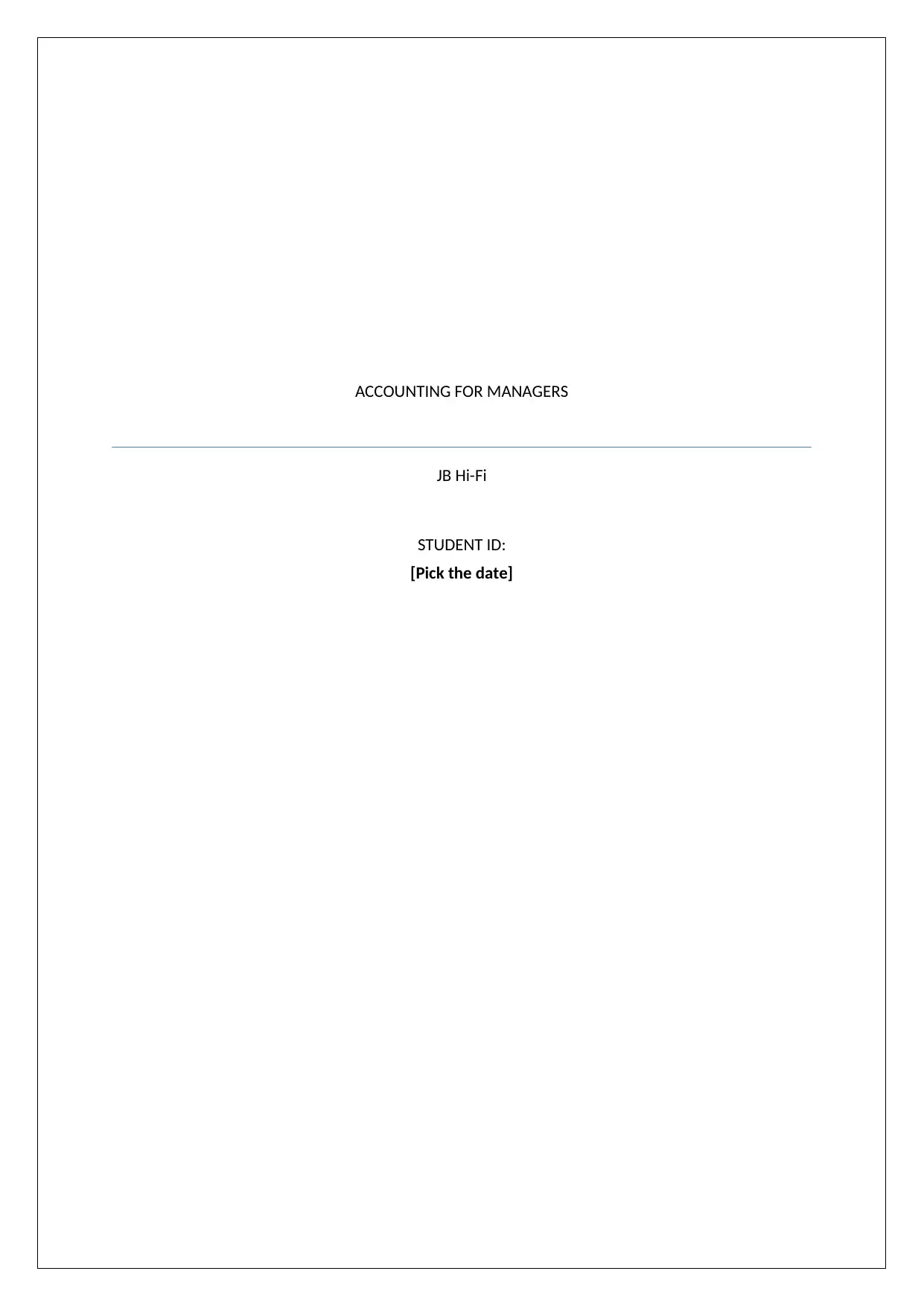
ACCOUNTING FOR MANAGERS
JB Hi-Fi
STUDENT ID:
[Pick the date]
JB Hi-Fi
STUDENT ID:
[Pick the date]
Secure Best Marks with AI Grader
Need help grading? Try our AI Grader for instant feedback on your assignments.
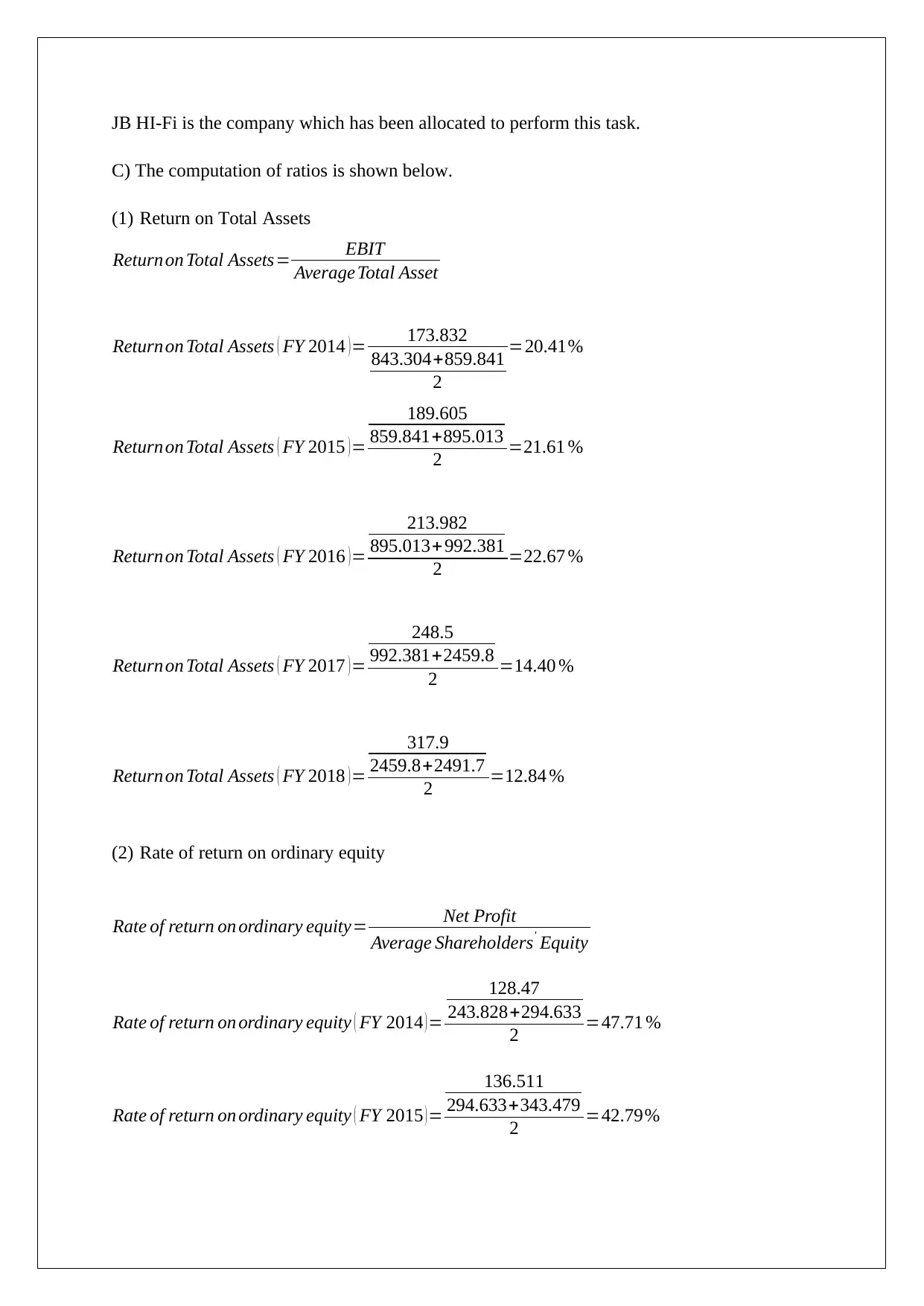
JB HI-Fi is the company which has been allocated to perform this task.
C) The computation of ratios is shown below.
(1) Return on Total Assets
Returnon Total Assets= EBIT
Average Total Asset
Returnon Total Assets ( FY 2014 ) = 173.832
843.304+859.841
2
=20.41%
Returnon Total Assets ( FY 2015 )=
189.605
859.841+895.013
2 =21.61 %
Returnon Total Assets ( FY 2016 ) =
213.982
895.013+ 992.381
2 =22.67 %
Returnon Total Assets ( FY 2017 )=
248.5
992.381+2459.8
2 =14.40 %
Returnon Total Assets ( FY 2018 )=
317.9
2459.8+2491.7
2 =12.84 %
(2) Rate of return on ordinary equity
Rate of return on ordinary equity= Net Profit
Average Shareholders' Equity
Rate of return on ordinary equity ( FY 2014 )=
128.47
243.828+294.633
2 =47.71 %
Rate of return on ordinary equity ( FY 2015 )=
136.511
294.633+343.479
2 =42.79%
C) The computation of ratios is shown below.
(1) Return on Total Assets
Returnon Total Assets= EBIT
Average Total Asset
Returnon Total Assets ( FY 2014 ) = 173.832
843.304+859.841
2
=20.41%
Returnon Total Assets ( FY 2015 )=
189.605
859.841+895.013
2 =21.61 %
Returnon Total Assets ( FY 2016 ) =
213.982
895.013+ 992.381
2 =22.67 %
Returnon Total Assets ( FY 2017 )=
248.5
992.381+2459.8
2 =14.40 %
Returnon Total Assets ( FY 2018 )=
317.9
2459.8+2491.7
2 =12.84 %
(2) Rate of return on ordinary equity
Rate of return on ordinary equity= Net Profit
Average Shareholders' Equity
Rate of return on ordinary equity ( FY 2014 )=
128.47
243.828+294.633
2 =47.71 %
Rate of return on ordinary equity ( FY 2015 )=
136.511
294.633+343.479
2 =42.79%
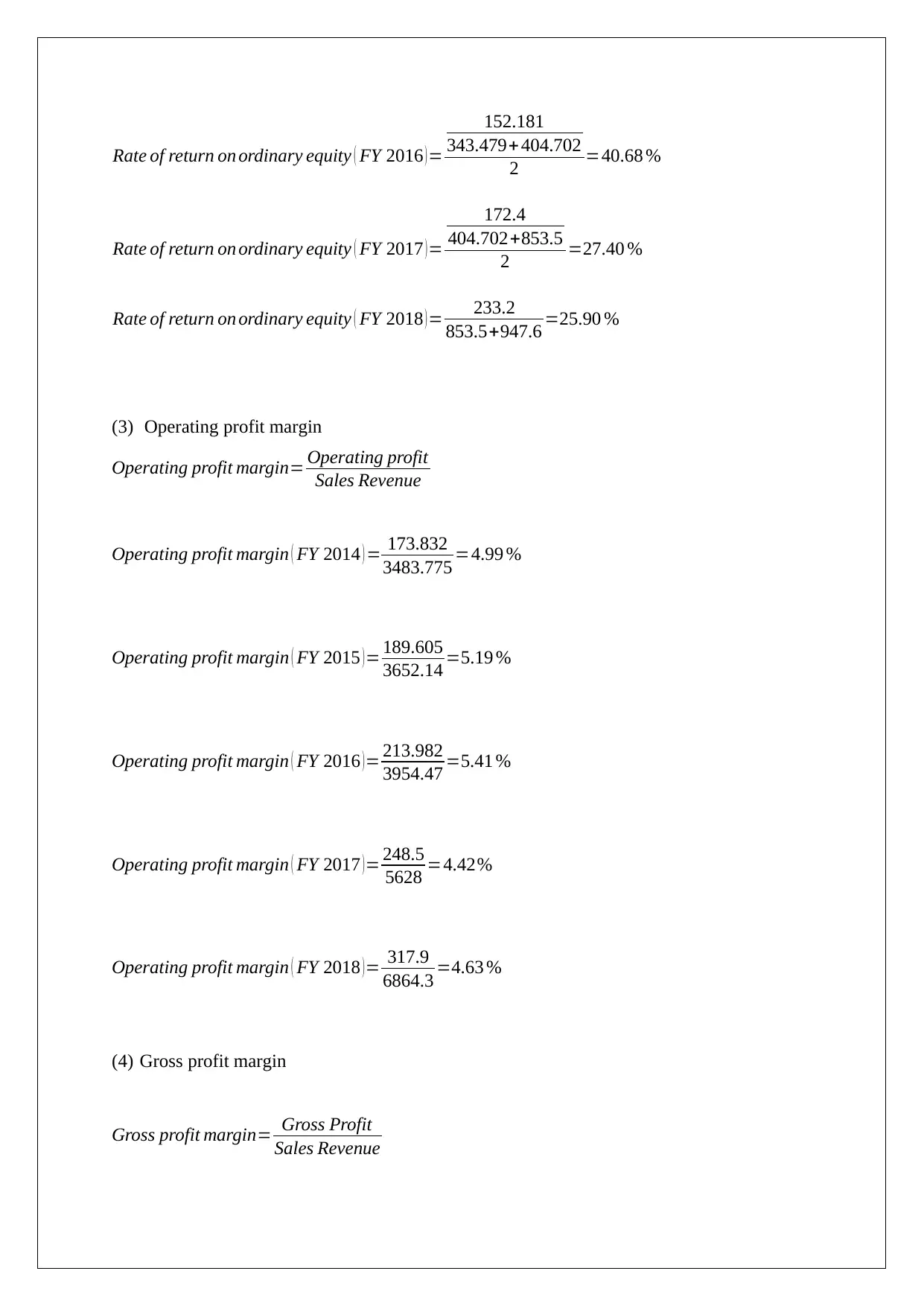
Rate of return on ordinary equity ( FY 2016 )=
152.181
343.479+ 404.702
2 =40.68 %
Rate of return on ordinary equity ( FY 2017 ) =
172.4
404.702+853.5
2 =27.40 %
Rate of return on ordinary equity ( FY 2018 )= 233.2
853.5+947.6 =25.90 %
(3) Operating profit margin
Operating profit margin= Operating profit
Sales Revenue
Operating profit margin ( FY 2014 ) = 173.832
3483.775 =4.99 %
Operating profit margin ( FY 2015 ) = 189.605
3652.14 =5.19 %
Operating profit margin ( FY 2016 )= 213.982
3954.47 =5.41 %
Operating profit margin ( FY 2017 )= 248.5
5628 =4.42%
Operating profit margin ( FY 2018 )= 317.9
6864.3 =4.63 %
(4) Gross profit margin
Gross profit margin= Gross Profit
Sales Revenue
152.181
343.479+ 404.702
2 =40.68 %
Rate of return on ordinary equity ( FY 2017 ) =
172.4
404.702+853.5
2 =27.40 %
Rate of return on ordinary equity ( FY 2018 )= 233.2
853.5+947.6 =25.90 %
(3) Operating profit margin
Operating profit margin= Operating profit
Sales Revenue
Operating profit margin ( FY 2014 ) = 173.832
3483.775 =4.99 %
Operating profit margin ( FY 2015 ) = 189.605
3652.14 =5.19 %
Operating profit margin ( FY 2016 )= 213.982
3954.47 =5.41 %
Operating profit margin ( FY 2017 )= 248.5
5628 =4.42%
Operating profit margin ( FY 2018 )= 317.9
6864.3 =4.63 %
(4) Gross profit margin
Gross profit margin= Gross Profit
Sales Revenue
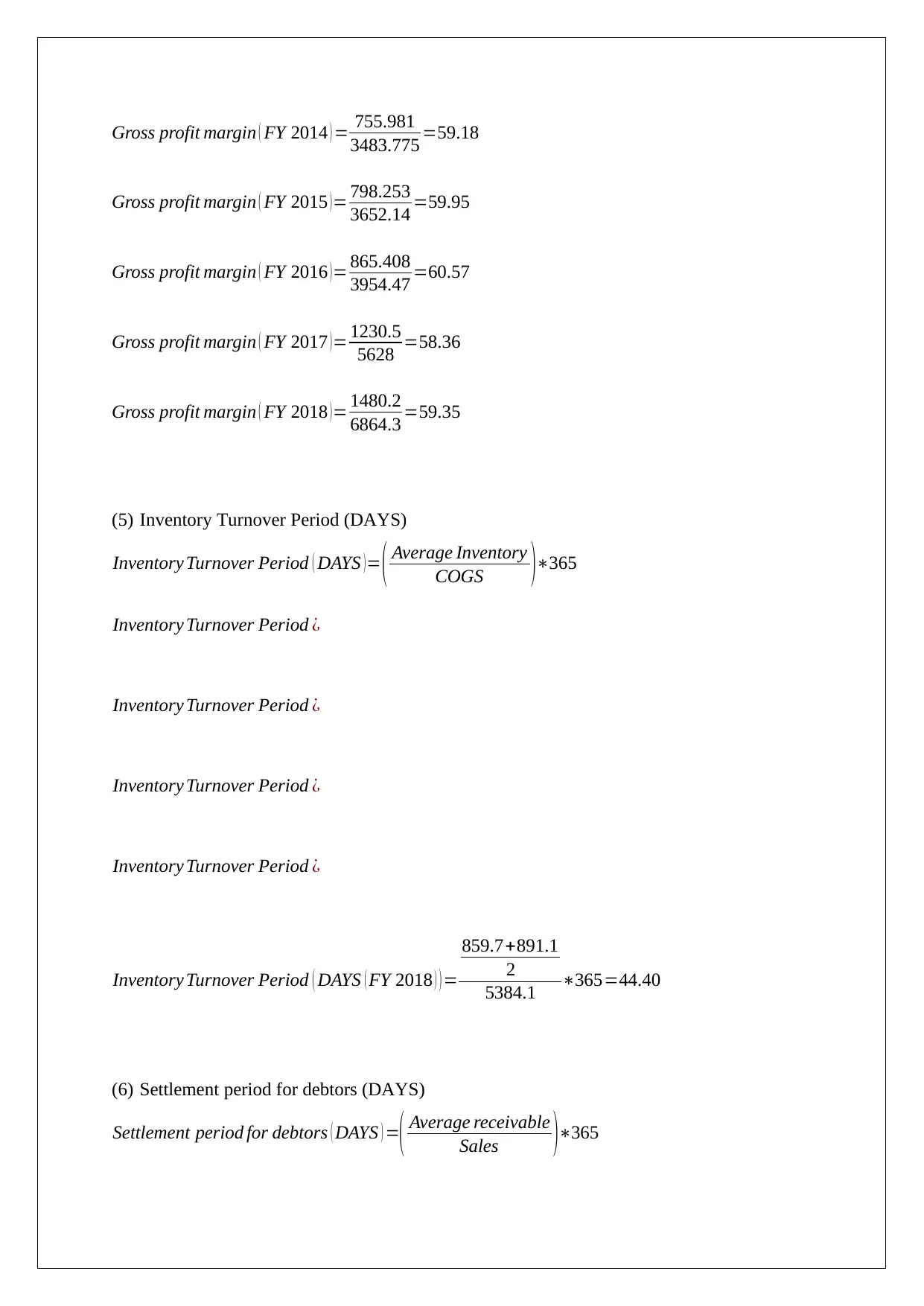
Gross profit margin ( FY 2014 ) = 755.981
3483.775 =59.18
Gross profit margin ( FY 2015 )= 798.253
3652.14 =59.95
Gross profit margin ( FY 2016 )= 865.408
3954.47 =60.57
Gross profit margin ( FY 2017 )= 1230.5
5628 =58.36
Gross profit margin ( FY 2018 )= 1480.2
6864.3 =59.35
(5) Inventory Turnover Period (DAYS)
Inventory Turnover Period ( DAYS )= ( Average Inventory
COGS )∗365
Inventory Turnover Period ¿
Inventory Turnover Period ¿
Inventory Turnover Period ¿
Inventory Turnover Period ¿
Inventory Turnover Period ( DAYS ( FY 2018 ) ) =
859.7+891.1
2
5384.1 ∗365=44.40
(6) Settlement period for debtors (DAYS)
Settlement period for debtors ( DAYS ) =( Average receivable
Sales )∗365
3483.775 =59.18
Gross profit margin ( FY 2015 )= 798.253
3652.14 =59.95
Gross profit margin ( FY 2016 )= 865.408
3954.47 =60.57
Gross profit margin ( FY 2017 )= 1230.5
5628 =58.36
Gross profit margin ( FY 2018 )= 1480.2
6864.3 =59.35
(5) Inventory Turnover Period (DAYS)
Inventory Turnover Period ( DAYS )= ( Average Inventory
COGS )∗365
Inventory Turnover Period ¿
Inventory Turnover Period ¿
Inventory Turnover Period ¿
Inventory Turnover Period ¿
Inventory Turnover Period ( DAYS ( FY 2018 ) ) =
859.7+891.1
2
5384.1 ∗365=44.40
(6) Settlement period for debtors (DAYS)
Settlement period for debtors ( DAYS ) =( Average receivable
Sales )∗365
Secure Best Marks with AI Grader
Need help grading? Try our AI Grader for instant feedback on your assignments.
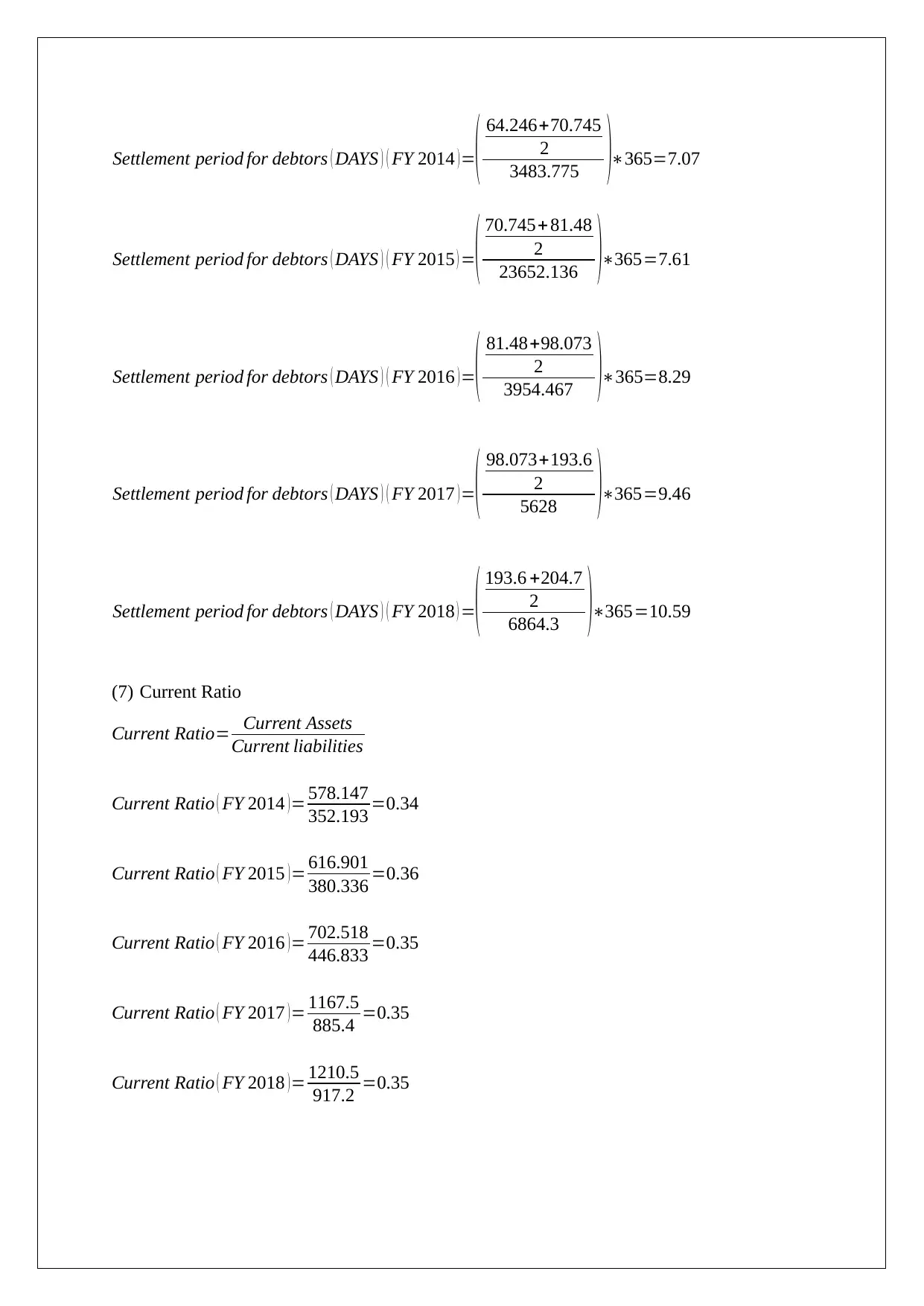
Settlement period for debtors ( DAYS ) ( FY 2014 )=( 64.246+70.745
2
3483.775 )∗365=7.07
Settlement period for debtors ( DAYS ) ( FY 2015 ) =( 70.745+ 81.48
2
23652.136 )∗365=7.61
Settlement period for debtors ( DAYS ) ( FY 2016 )=( 81.48+98.073
2
3954.467 )∗365=8.29
Settlement period for debtors ( DAYS ) ( FY 2017 ) =( 98.073+193.6
2
5628 )∗365=9.46
Settlement period for debtors ( DAYS ) ( FY 2018 ) =( 193.6 +204.7
2
6864.3 )∗365=10.59
(7) Current Ratio
Current Ratio= Current Assets
Current liabilities
Current Ratio ( FY 2014 )= 578.147
352.193 =0.34
Current Ratio ( FY 2015 ) = 616.901
380.336 =0.36
Current Ratio ( FY 2016 )= 702.518
446.833 =0.35
Current Ratio ( FY 2017 )= 1167.5
885.4 =0.35
Current Ratio ( FY 2018 )= 1210.5
917.2 =0.35
2
3483.775 )∗365=7.07
Settlement period for debtors ( DAYS ) ( FY 2015 ) =( 70.745+ 81.48
2
23652.136 )∗365=7.61
Settlement period for debtors ( DAYS ) ( FY 2016 )=( 81.48+98.073
2
3954.467 )∗365=8.29
Settlement period for debtors ( DAYS ) ( FY 2017 ) =( 98.073+193.6
2
5628 )∗365=9.46
Settlement period for debtors ( DAYS ) ( FY 2018 ) =( 193.6 +204.7
2
6864.3 )∗365=10.59
(7) Current Ratio
Current Ratio= Current Assets
Current liabilities
Current Ratio ( FY 2014 )= 578.147
352.193 =0.34
Current Ratio ( FY 2015 ) = 616.901
380.336 =0.36
Current Ratio ( FY 2016 )= 702.518
446.833 =0.35
Current Ratio ( FY 2017 )= 1167.5
885.4 =0.35
Current Ratio ( FY 2018 )= 1210.5
917.2 =0.35
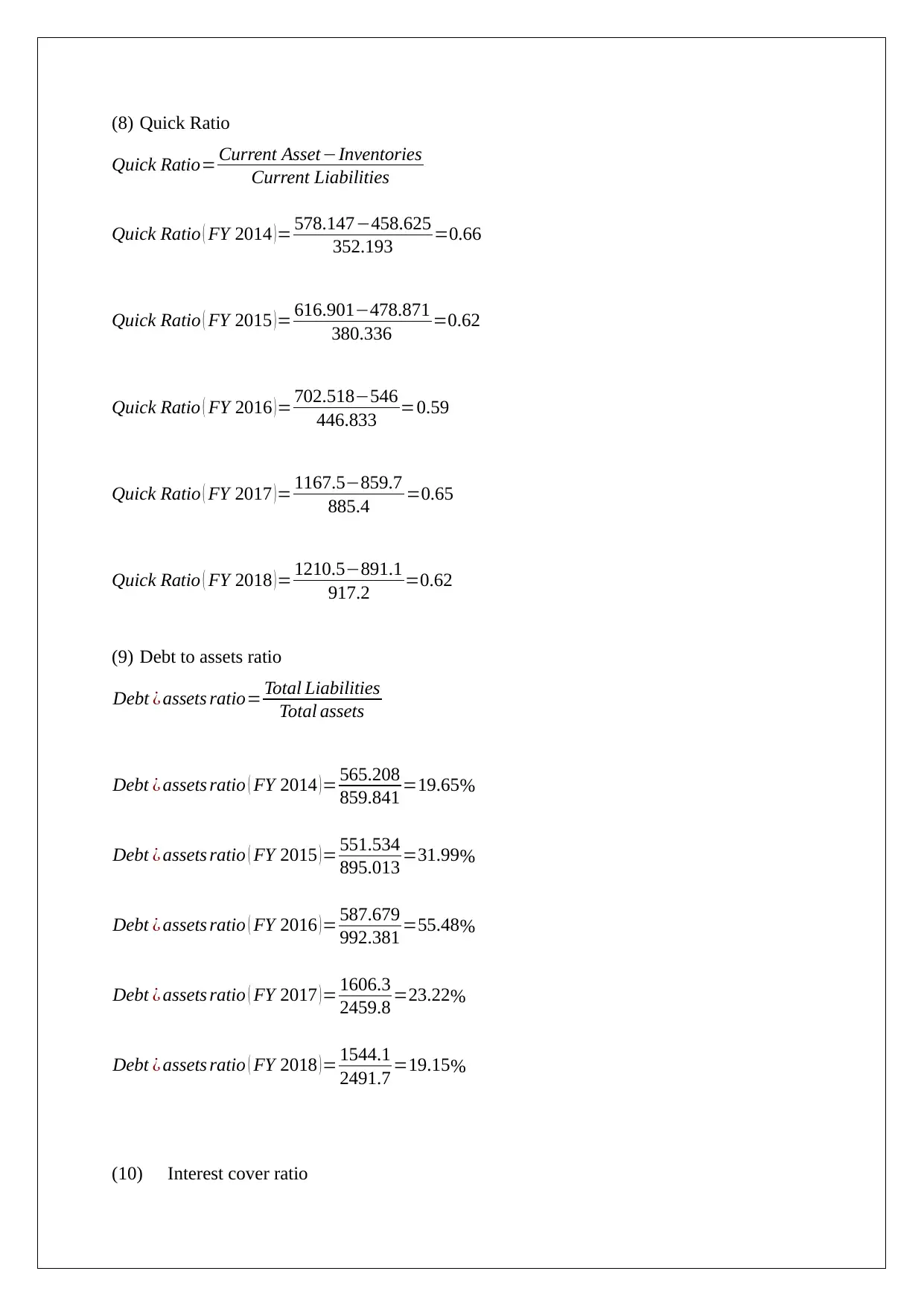
(8) Quick Ratio
Quick Ratio= Current Asset−Inventories
Current Liabilities
Quick Ratio ( FY 2014 )= 578.147−458.625
352.193 =0.66
Quick Ratio ( FY 2015 )= 616.901−478.871
380.336 =0.62
Quick Ratio ( FY 2016 ) = 702.518−546
446.833 =0.59
Quick Ratio ( FY 2017 )= 1167.5−859.7
885.4 =0.65
Quick Ratio ( FY 2018 ) = 1210.5−891.1
917.2 =0.62
(9) Debt to assets ratio
Debt ¿ assets ratio= Total Liabilities
Total assets
Debt ¿ assets ratio ( FY 2014 )= 565.208
859.841 =19.65%
Debt ¿ assets ratio ( FY 2015 )= 551.534
895.013 =31.99%
Debt ¿ assets ratio ( FY 2016 )= 587.679
992.381 =55.48%
Debt ¿ assets ratio ( FY 2017 )= 1606.3
2459.8 =23.22%
Debt ¿ assets ratio ( FY 2018 )= 1544.1
2491.7 =19.15%
(10) Interest cover ratio
Quick Ratio= Current Asset−Inventories
Current Liabilities
Quick Ratio ( FY 2014 )= 578.147−458.625
352.193 =0.66
Quick Ratio ( FY 2015 )= 616.901−478.871
380.336 =0.62
Quick Ratio ( FY 2016 ) = 702.518−546
446.833 =0.59
Quick Ratio ( FY 2017 )= 1167.5−859.7
885.4 =0.65
Quick Ratio ( FY 2018 ) = 1210.5−891.1
917.2 =0.62
(9) Debt to assets ratio
Debt ¿ assets ratio= Total Liabilities
Total assets
Debt ¿ assets ratio ( FY 2014 )= 565.208
859.841 =19.65%
Debt ¿ assets ratio ( FY 2015 )= 551.534
895.013 =31.99%
Debt ¿ assets ratio ( FY 2016 )= 587.679
992.381 =55.48%
Debt ¿ assets ratio ( FY 2017 )= 1606.3
2459.8 =23.22%
Debt ¿ assets ratio ( FY 2018 )= 1544.1
2491.7 =19.15%
(10) Interest cover ratio
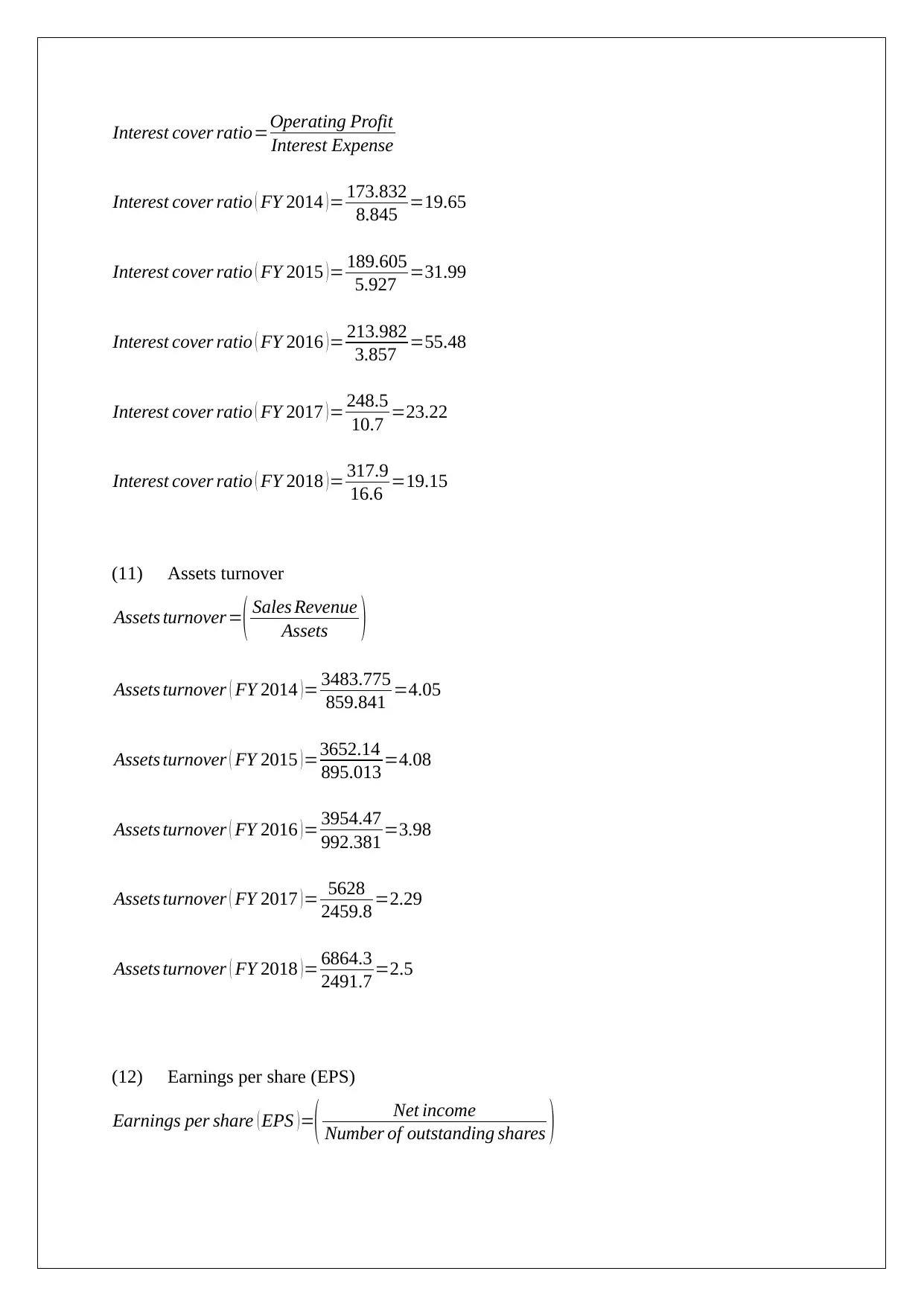
Interest cover ratio=Operating Profit
Interest Expense
Interest cover ratio ( FY 2014 )= 173.832
8.845 =19.65
Interest cover ratio ( FY 2015 ) = 189.605
5.927 =31.99
Interest cover ratio ( FY 2016 ) = 213.982
3.857 =55.48
Interest cover ratio ( FY 2017 )= 248.5
10.7 =23.22
Interest cover ratio ( FY 2018 ) = 317.9
16.6 =19.15
(11) Assets turnover
Assets turnover=( Sales Revenue
Assets )
Assets turnover ( FY 2014 ) = 3483.775
859.841 =4.05
Assets turnover ( FY 2015 )=3652.14
895.013 =4.08
Assets turnover ( FY 2016 )= 3954.47
992.381 =3.98
Assets turnover ( FY 2017 )= 5628
2459.8 =2.29
Assets turnover ( FY 2018 ) = 6864.3
2491.7 =2.5
(12) Earnings per share (EPS)
Earnings per share ( EPS )=( Net income
Number of outstanding shares )
Interest Expense
Interest cover ratio ( FY 2014 )= 173.832
8.845 =19.65
Interest cover ratio ( FY 2015 ) = 189.605
5.927 =31.99
Interest cover ratio ( FY 2016 ) = 213.982
3.857 =55.48
Interest cover ratio ( FY 2017 )= 248.5
10.7 =23.22
Interest cover ratio ( FY 2018 ) = 317.9
16.6 =19.15
(11) Assets turnover
Assets turnover=( Sales Revenue
Assets )
Assets turnover ( FY 2014 ) = 3483.775
859.841 =4.05
Assets turnover ( FY 2015 )=3652.14
895.013 =4.08
Assets turnover ( FY 2016 )= 3954.47
992.381 =3.98
Assets turnover ( FY 2017 )= 5628
2459.8 =2.29
Assets turnover ( FY 2018 ) = 6864.3
2491.7 =2.5
(12) Earnings per share (EPS)
Earnings per share ( EPS )=( Net income
Number of outstanding shares )
Paraphrase This Document
Need a fresh take? Get an instant paraphrase of this document with our AI Paraphraser
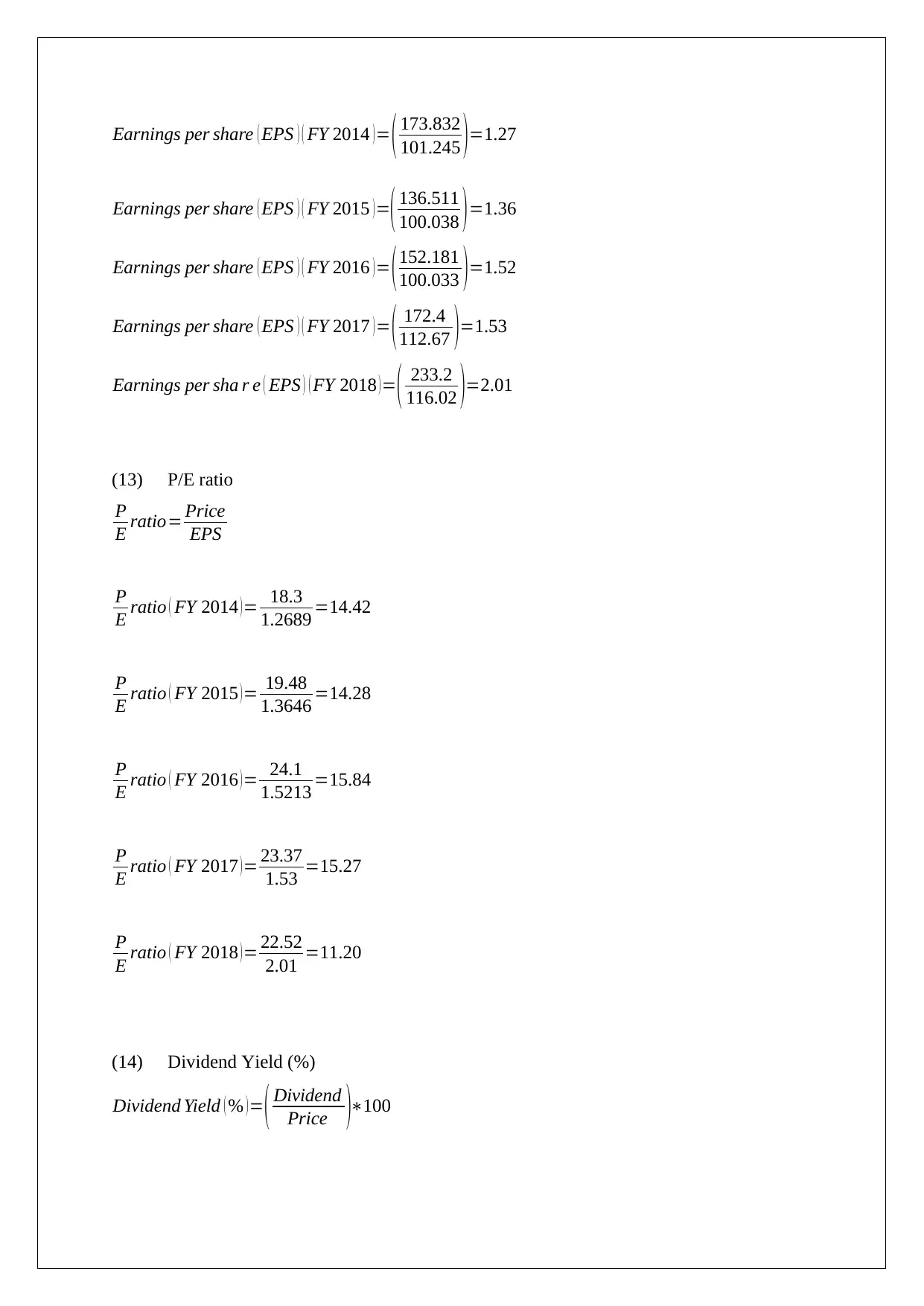
Earnings per share ( EPS ) ( FY 2014 )= ( 173.832
101.245 )=1.27
Earnings per share ( EPS ) ( FY 2015 )=( 136.511
100.038 )=1.36
Earnings per share ( EPS ) ( FY 2016 )= (152.181
100.033 )=1.52
Earnings per share ( EPS ) ( FY 2017 ) = ( 172.4
112.67 )=1.53
Earnings per sha r e ( EPS ) ( FY 2018 ) = ( 233.2
116.02 )=2.01
(13) P/E ratio
P
E ratio= Price
EPS
P
E ratio ( FY 2014 ) = 18.3
1.2689 =14.42
P
E ratio ( FY 2015 ) = 19.48
1.3646 =14.28
P
E ratio ( FY 2016 )= 24.1
1.5213 =15.84
P
E ratio ( FY 2017 )= 23.37
1.53 =15.27
P
E ratio ( FY 2018 )= 22.52
2.01 =11.20
(14) Dividend Yield (%)
Dividend Yield ( % ) = ( Dividend
Price )∗100
101.245 )=1.27
Earnings per share ( EPS ) ( FY 2015 )=( 136.511
100.038 )=1.36
Earnings per share ( EPS ) ( FY 2016 )= (152.181
100.033 )=1.52
Earnings per share ( EPS ) ( FY 2017 ) = ( 172.4
112.67 )=1.53
Earnings per sha r e ( EPS ) ( FY 2018 ) = ( 233.2
116.02 )=2.01
(13) P/E ratio
P
E ratio= Price
EPS
P
E ratio ( FY 2014 ) = 18.3
1.2689 =14.42
P
E ratio ( FY 2015 ) = 19.48
1.3646 =14.28
P
E ratio ( FY 2016 )= 24.1
1.5213 =15.84
P
E ratio ( FY 2017 )= 23.37
1.53 =15.27
P
E ratio ( FY 2018 )= 22.52
2.01 =11.20
(14) Dividend Yield (%)
Dividend Yield ( % ) = ( Dividend
Price )∗100

Dividend Yield ( % ) ( FY 2014 ) =( 0.77
18.3 )∗100=4.21 %
Dividend Yield ( % ) ( FY 2015 ) = ( 0.88
19.48 )∗100=4.52 %
Dividend Yield ( % ) ( FY 2016 )= ( 0.94
24.1 )∗100=3.90 %
Dividend Yield ( % ) ( FY 2017 )= ( 1.09
23.37 )∗100=4.66 %
Dividend Yield ( % ) ( FY 2018 )= ( 1.32
22.52 )∗100=5.86 %
D) The objective is to carry out an analysis of the financial performance of the company on
the basis of the ratios determined above.
Profitability Ratios
The profitability ratios highlight the profitability trends of the continuing operations of the
firm and is a key performance metric since the profitability of the operations tend to impact
the EPS which in-turn impact the firm value (Brigham and Houston, 2014).
For JB Hi-Fi, the return on total assets showed a positive trend during the initial three years
of the period under consideration but there was a reversal noticed in FY2017. The positive
trend was on account of healthy growth in EBIT driven by company’s effort to improve the
productivity and cut down on the indirect expenditures which boosted the operating profit
margins. In FY2017, the company concluded the acquisition of home appliance major for $
870 million which was concluded only in middle of the year (Mitchell, 2016). Thus, the
financial statements in FY2017 represented revenues only partially while the assets
representation was complete which is responsible for the steep fall. However, the fact that the
return on total assets has not improved in FY2018 is a matter of concern (JB Hi-Fi, 2018).
In contrast, the return on equity has decreased during the five years under consideration.
During the period FY2014-FY2016, this decrease is mainly on account of increasing retained
earnings leading to higher shareholders’ equity (JB Hi-Fi, 2016). However, the sharp fall in
this ratio in 2017 is caused by the raising of fresh equity to the extent of $ 395 million which
has caused the shareholders’ equity to double from FY2016 to FY2017. The gross profit
18.3 )∗100=4.21 %
Dividend Yield ( % ) ( FY 2015 ) = ( 0.88
19.48 )∗100=4.52 %
Dividend Yield ( % ) ( FY 2016 )= ( 0.94
24.1 )∗100=3.90 %
Dividend Yield ( % ) ( FY 2017 )= ( 1.09
23.37 )∗100=4.66 %
Dividend Yield ( % ) ( FY 2018 )= ( 1.32
22.52 )∗100=5.86 %
D) The objective is to carry out an analysis of the financial performance of the company on
the basis of the ratios determined above.
Profitability Ratios
The profitability ratios highlight the profitability trends of the continuing operations of the
firm and is a key performance metric since the profitability of the operations tend to impact
the EPS which in-turn impact the firm value (Brigham and Houston, 2014).
For JB Hi-Fi, the return on total assets showed a positive trend during the initial three years
of the period under consideration but there was a reversal noticed in FY2017. The positive
trend was on account of healthy growth in EBIT driven by company’s effort to improve the
productivity and cut down on the indirect expenditures which boosted the operating profit
margins. In FY2017, the company concluded the acquisition of home appliance major for $
870 million which was concluded only in middle of the year (Mitchell, 2016). Thus, the
financial statements in FY2017 represented revenues only partially while the assets
representation was complete which is responsible for the steep fall. However, the fact that the
return on total assets has not improved in FY2018 is a matter of concern (JB Hi-Fi, 2018).
In contrast, the return on equity has decreased during the five years under consideration.
During the period FY2014-FY2016, this decrease is mainly on account of increasing retained
earnings leading to higher shareholders’ equity (JB Hi-Fi, 2016). However, the sharp fall in
this ratio in 2017 is caused by the raising of fresh equity to the extent of $ 395 million which
has caused the shareholders’ equity to double from FY2016 to FY2017. The gross profit
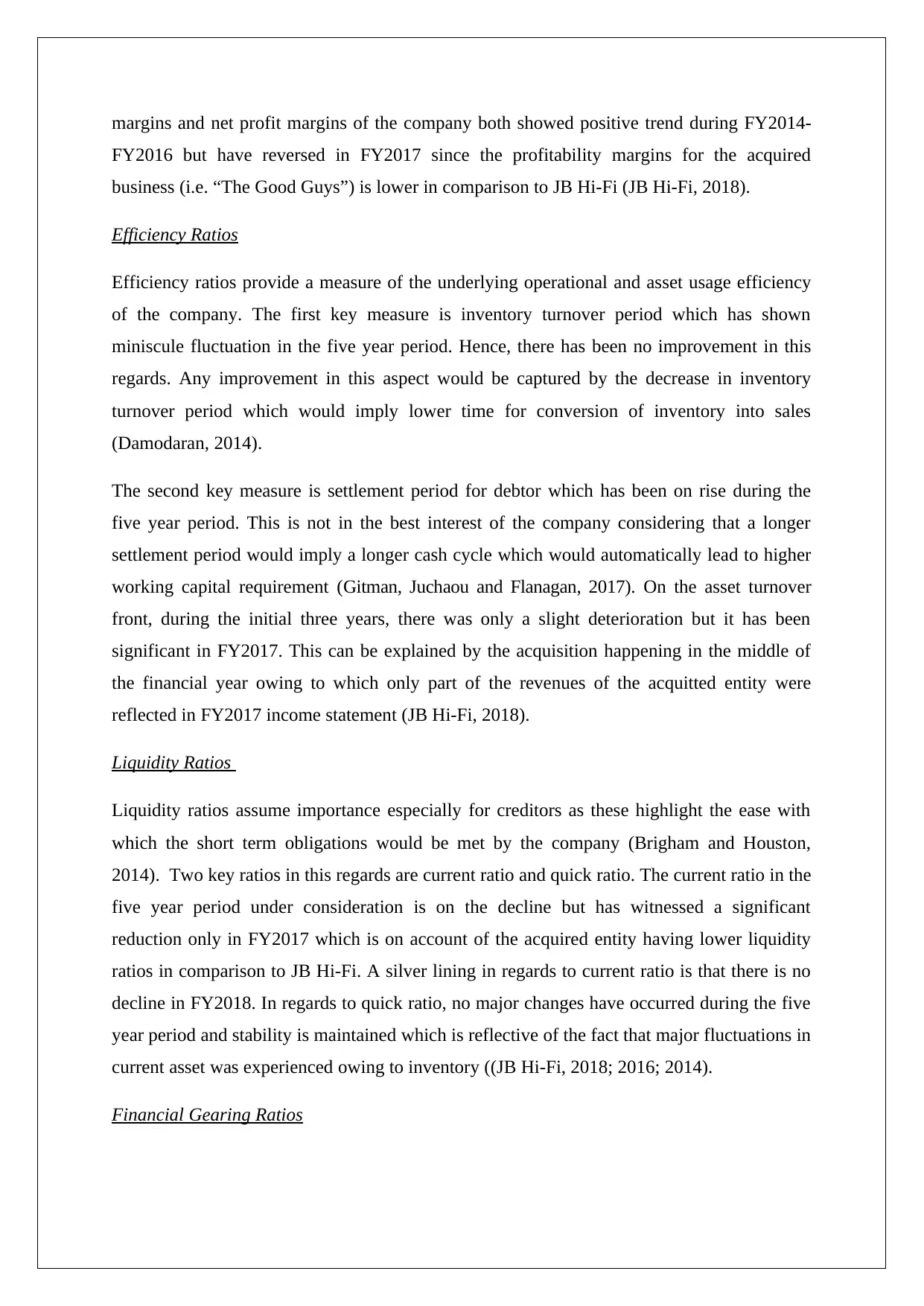
margins and net profit margins of the company both showed positive trend during FY2014-
FY2016 but have reversed in FY2017 since the profitability margins for the acquired
business (i.e. “The Good Guys”) is lower in comparison to JB Hi-Fi (JB Hi-Fi, 2018).
Efficiency Ratios
Efficiency ratios provide a measure of the underlying operational and asset usage efficiency
of the company. The first key measure is inventory turnover period which has shown
miniscule fluctuation in the five year period. Hence, there has been no improvement in this
regards. Any improvement in this aspect would be captured by the decrease in inventory
turnover period which would imply lower time for conversion of inventory into sales
(Damodaran, 2014).
The second key measure is settlement period for debtor which has been on rise during the
five year period. This is not in the best interest of the company considering that a longer
settlement period would imply a longer cash cycle which would automatically lead to higher
working capital requirement (Gitman, Juchaou and Flanagan, 2017). On the asset turnover
front, during the initial three years, there was only a slight deterioration but it has been
significant in FY2017. This can be explained by the acquisition happening in the middle of
the financial year owing to which only part of the revenues of the acquitted entity were
reflected in FY2017 income statement (JB Hi-Fi, 2018).
Liquidity Ratios
Liquidity ratios assume importance especially for creditors as these highlight the ease with
which the short term obligations would be met by the company (Brigham and Houston,
2014). Two key ratios in this regards are current ratio and quick ratio. The current ratio in the
five year period under consideration is on the decline but has witnessed a significant
reduction only in FY2017 which is on account of the acquired entity having lower liquidity
ratios in comparison to JB Hi-Fi. A silver lining in regards to current ratio is that there is no
decline in FY2018. In regards to quick ratio, no major changes have occurred during the five
year period and stability is maintained which is reflective of the fact that major fluctuations in
current asset was experienced owing to inventory ((JB Hi-Fi, 2018; 2016; 2014).
Financial Gearing Ratios
FY2016 but have reversed in FY2017 since the profitability margins for the acquired
business (i.e. “The Good Guys”) is lower in comparison to JB Hi-Fi (JB Hi-Fi, 2018).
Efficiency Ratios
Efficiency ratios provide a measure of the underlying operational and asset usage efficiency
of the company. The first key measure is inventory turnover period which has shown
miniscule fluctuation in the five year period. Hence, there has been no improvement in this
regards. Any improvement in this aspect would be captured by the decrease in inventory
turnover period which would imply lower time for conversion of inventory into sales
(Damodaran, 2014).
The second key measure is settlement period for debtor which has been on rise during the
five year period. This is not in the best interest of the company considering that a longer
settlement period would imply a longer cash cycle which would automatically lead to higher
working capital requirement (Gitman, Juchaou and Flanagan, 2017). On the asset turnover
front, during the initial three years, there was only a slight deterioration but it has been
significant in FY2017. This can be explained by the acquisition happening in the middle of
the financial year owing to which only part of the revenues of the acquitted entity were
reflected in FY2017 income statement (JB Hi-Fi, 2018).
Liquidity Ratios
Liquidity ratios assume importance especially for creditors as these highlight the ease with
which the short term obligations would be met by the company (Brigham and Houston,
2014). Two key ratios in this regards are current ratio and quick ratio. The current ratio in the
five year period under consideration is on the decline but has witnessed a significant
reduction only in FY2017 which is on account of the acquired entity having lower liquidity
ratios in comparison to JB Hi-Fi. A silver lining in regards to current ratio is that there is no
decline in FY2018. In regards to quick ratio, no major changes have occurred during the five
year period and stability is maintained which is reflective of the fact that major fluctuations in
current asset was experienced owing to inventory ((JB Hi-Fi, 2018; 2016; 2014).
Financial Gearing Ratios
Secure Best Marks with AI Grader
Need help grading? Try our AI Grader for instant feedback on your assignments.

These ratios tend to signify the ease with which the company can fulfil long term
commitments (Damodaran, 2014). There is a positive trend in regards to debt to assets ratio
which has reached the lowest point at the end of FY2016. This highlights the minimum
leveraging of the balance sheet was achieved at the end of FY2016 (JB Hi-Fi, 2016).
However, in FY2017, there is a sudden jump which does not come as a surprise considering
that company raised debt to the tune of $ 500 million to fund the acquisition. A positive
observation is the return of thee trend of lowering debt to assets ratio in FY2018 which
highlights management commitment to lowering the debt on the books (JB Hi-Fi, 2018).
The peaking of the interest cover also happens in FY2016 since the interest cost was at the
lowest point and operating profit at a high point. However, in FY2017 there is a decline in
this regards as the interest expense has shot up in a disproportionate manner as compared to
operating profit. Despite the decline in interest cover in FY2017 and FY2018, the company is
able to provide enough cover to meet the interest obligations (JB Hi-Fi, 2018).
Investment Ratios
The EPS of the company has witnessed a strong growth in the five years under consideration
but majority of this growth has been achieved in FY2018. The key contribution of this growth
is not the superior performance of the company but the acquisition of another entity with
significant profits and complementary product line of home appliances. The P/E ratio also is
indicative of lacklustre organic growth of business owing to which there has not been any P/E
expansion and in the recent times it has contracted on account of the acquisition and the
related risks assumed. From an investor perspective, the healthy divided yield is a significant
positive for the stock (Gitman, Juchaou and Flanagan, 2017).
E) To compare the cash flow statements for the year ending June 30, 2017 and June 30, 2018,
the three key aspects of the statement have been compared with each other.
Cash flows from operating activities
The requisite extract from the cash flow statement of FY2018 annual report is presented
below.
commitments (Damodaran, 2014). There is a positive trend in regards to debt to assets ratio
which has reached the lowest point at the end of FY2016. This highlights the minimum
leveraging of the balance sheet was achieved at the end of FY2016 (JB Hi-Fi, 2016).
However, in FY2017, there is a sudden jump which does not come as a surprise considering
that company raised debt to the tune of $ 500 million to fund the acquisition. A positive
observation is the return of thee trend of lowering debt to assets ratio in FY2018 which
highlights management commitment to lowering the debt on the books (JB Hi-Fi, 2018).
The peaking of the interest cover also happens in FY2016 since the interest cost was at the
lowest point and operating profit at a high point. However, in FY2017 there is a decline in
this regards as the interest expense has shot up in a disproportionate manner as compared to
operating profit. Despite the decline in interest cover in FY2017 and FY2018, the company is
able to provide enough cover to meet the interest obligations (JB Hi-Fi, 2018).
Investment Ratios
The EPS of the company has witnessed a strong growth in the five years under consideration
but majority of this growth has been achieved in FY2018. The key contribution of this growth
is not the superior performance of the company but the acquisition of another entity with
significant profits and complementary product line of home appliances. The P/E ratio also is
indicative of lacklustre organic growth of business owing to which there has not been any P/E
expansion and in the recent times it has contracted on account of the acquisition and the
related risks assumed. From an investor perspective, the healthy divided yield is a significant
positive for the stock (Gitman, Juchaou and Flanagan, 2017).
E) To compare the cash flow statements for the year ending June 30, 2017 and June 30, 2018,
the three key aspects of the statement have been compared with each other.
Cash flows from operating activities
The requisite extract from the cash flow statement of FY2018 annual report is presented
below.
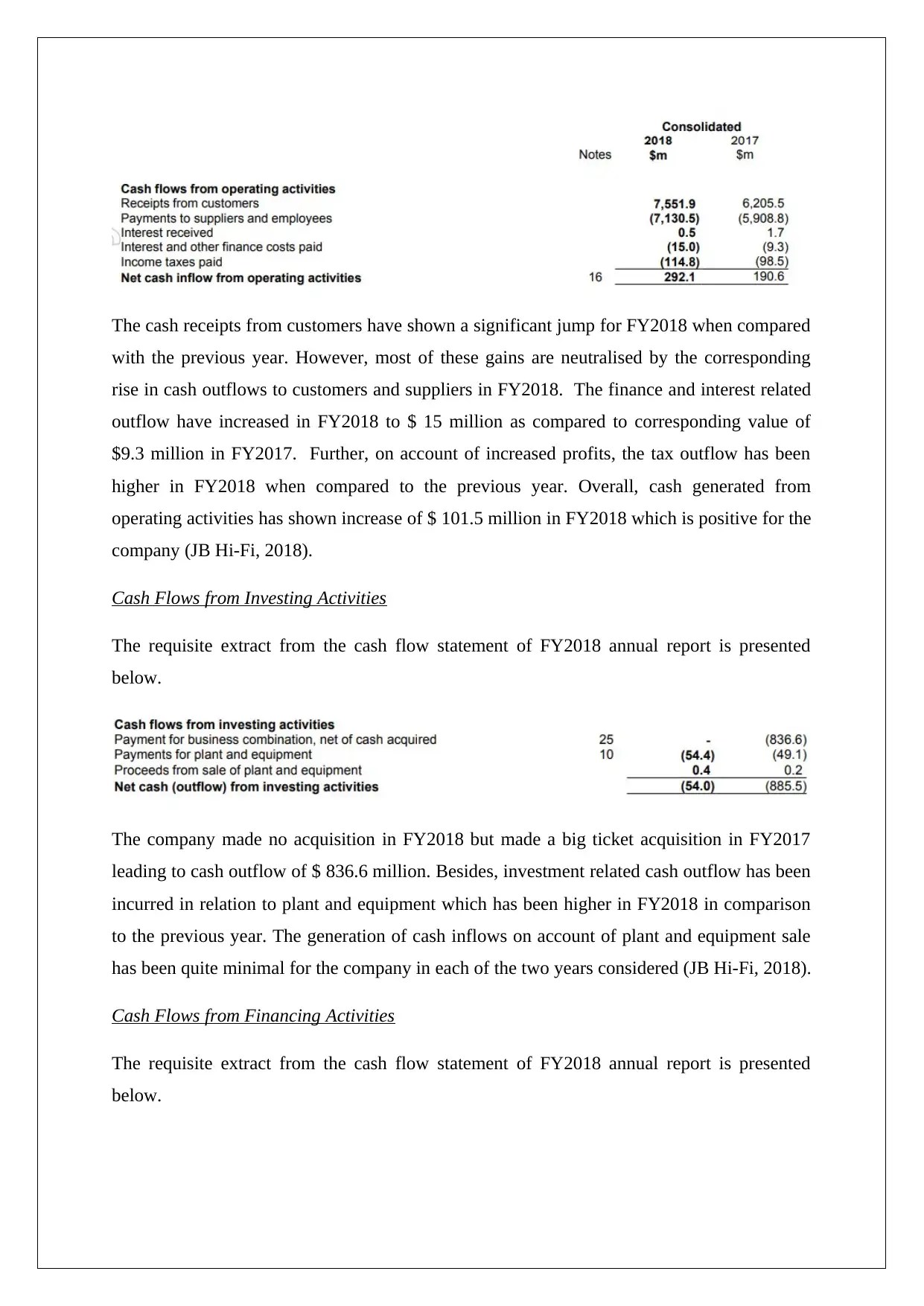
The cash receipts from customers have shown a significant jump for FY2018 when compared
with the previous year. However, most of these gains are neutralised by the corresponding
rise in cash outflows to customers and suppliers in FY2018. The finance and interest related
outflow have increased in FY2018 to $ 15 million as compared to corresponding value of
$9.3 million in FY2017. Further, on account of increased profits, the tax outflow has been
higher in FY2018 when compared to the previous year. Overall, cash generated from
operating activities has shown increase of $ 101.5 million in FY2018 which is positive for the
company (JB Hi-Fi, 2018).
Cash Flows from Investing Activities
The requisite extract from the cash flow statement of FY2018 annual report is presented
below.
The company made no acquisition in FY2018 but made a big ticket acquisition in FY2017
leading to cash outflow of $ 836.6 million. Besides, investment related cash outflow has been
incurred in relation to plant and equipment which has been higher in FY2018 in comparison
to the previous year. The generation of cash inflows on account of plant and equipment sale
has been quite minimal for the company in each of the two years considered (JB Hi-Fi, 2018).
Cash Flows from Financing Activities
The requisite extract from the cash flow statement of FY2018 annual report is presented
below.
with the previous year. However, most of these gains are neutralised by the corresponding
rise in cash outflows to customers and suppliers in FY2018. The finance and interest related
outflow have increased in FY2018 to $ 15 million as compared to corresponding value of
$9.3 million in FY2017. Further, on account of increased profits, the tax outflow has been
higher in FY2018 when compared to the previous year. Overall, cash generated from
operating activities has shown increase of $ 101.5 million in FY2018 which is positive for the
company (JB Hi-Fi, 2018).
Cash Flows from Investing Activities
The requisite extract from the cash flow statement of FY2018 annual report is presented
below.
The company made no acquisition in FY2018 but made a big ticket acquisition in FY2017
leading to cash outflow of $ 836.6 million. Besides, investment related cash outflow has been
incurred in relation to plant and equipment which has been higher in FY2018 in comparison
to the previous year. The generation of cash inflows on account of plant and equipment sale
has been quite minimal for the company in each of the two years considered (JB Hi-Fi, 2018).
Cash Flows from Financing Activities
The requisite extract from the cash flow statement of FY2018 annual report is presented
below.

A significant equity based funding was carried by the company in FY2017 which led to cash
inflow of $ 395.9 million. Additionally, in the same year, a debt of $ 450 million was also
raised by the company. This was done in order to complete the acquisition of home
appliances major “The Good Guys”. As the profits of the company have soared in FY2018,
the respective divided outflow has also increased (JB Hi-Fi, 2018).
References
Brigham, E. F. and Houston, J. F., (2014). .Fundamentals of Financial Management, Boston:
Cengage Learning.
Damodaran, A. (2014). Applied corporate finance: A user’s manual, New York: Wiley, John
& Sons.
Gitman, L.J., Juchaou, R., and Flanagan, J. (2017).Principles of Managerial Finance NSW:
Pearson Australia
JB Hi-Fi (2014) Annual Report FY2014, [Online] Available at
http://www.annualreports.com/HostedData/AnnualReportArchive/J/ASX_JBH_2014.pdf
[Assessed December 2, 2018]
JB Hi-Fi (2016) Annual Report FY2016, [Online] Available at
http://www.annualreports.com/HostedData/AnnualReportArchive/J/ASX_JBH_2016.pdf
[Assessed December 2, 2018]
JB Hi-Fi (2018) Annual Report FY2018, [Online] Available at
https://investors.jbhifi.com.au/wp-content/uploads/2018/10/Annual-Report-2018-with-
Chairmans-CEOs-Report.pdf [Assessed December 2, 2018]
Mitchell, S. (2016) JB Hi-Fi agrees to buy The Good Guys for $870m, [Online] Available at
https://www.afr.com/business/retail/appliances/jb-hifi-agrees-to-buy-the-good-guys-for-
870m-20160912-grev25 [Assessed December 2, 2018]
inflow of $ 395.9 million. Additionally, in the same year, a debt of $ 450 million was also
raised by the company. This was done in order to complete the acquisition of home
appliances major “The Good Guys”. As the profits of the company have soared in FY2018,
the respective divided outflow has also increased (JB Hi-Fi, 2018).
References
Brigham, E. F. and Houston, J. F., (2014). .Fundamentals of Financial Management, Boston:
Cengage Learning.
Damodaran, A. (2014). Applied corporate finance: A user’s manual, New York: Wiley, John
& Sons.
Gitman, L.J., Juchaou, R., and Flanagan, J. (2017).Principles of Managerial Finance NSW:
Pearson Australia
JB Hi-Fi (2014) Annual Report FY2014, [Online] Available at
http://www.annualreports.com/HostedData/AnnualReportArchive/J/ASX_JBH_2014.pdf
[Assessed December 2, 2018]
JB Hi-Fi (2016) Annual Report FY2016, [Online] Available at
http://www.annualreports.com/HostedData/AnnualReportArchive/J/ASX_JBH_2016.pdf
[Assessed December 2, 2018]
JB Hi-Fi (2018) Annual Report FY2018, [Online] Available at
https://investors.jbhifi.com.au/wp-content/uploads/2018/10/Annual-Report-2018-with-
Chairmans-CEOs-Report.pdf [Assessed December 2, 2018]
Mitchell, S. (2016) JB Hi-Fi agrees to buy The Good Guys for $870m, [Online] Available at
https://www.afr.com/business/retail/appliances/jb-hifi-agrees-to-buy-the-good-guys-for-
870m-20160912-grev25 [Assessed December 2, 2018]
Paraphrase This Document
Need a fresh take? Get an instant paraphrase of this document with our AI Paraphraser

1 out of 14
Related Documents
Your All-in-One AI-Powered Toolkit for Academic Success.
+13062052269
info@desklib.com
Available 24*7 on WhatsApp / Email
![[object Object]](/_next/static/media/star-bottom.7253800d.svg)
Unlock your academic potential
© 2024 | Zucol Services PVT LTD | All rights reserved.





